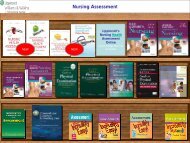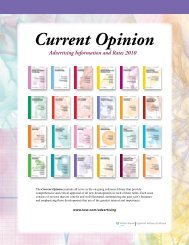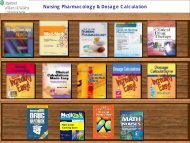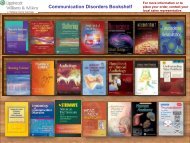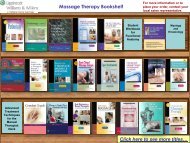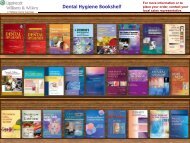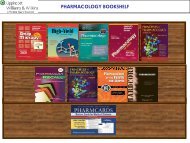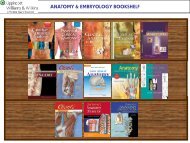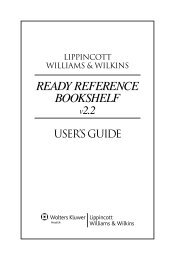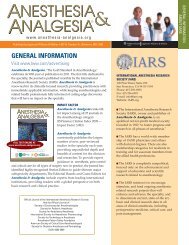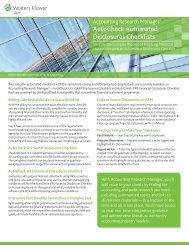Nurse Assisting (CNA)
Nurse Assisting (CNA)
Nurse Assisting (CNA)
Create successful ePaper yourself
Turn your PDF publications into a flip-book with our unique Google optimized e-Paper software.
<strong>Nurse</strong> <strong>Assisting</strong> (<strong>CNA</strong>)<br />
Workbook<br />
coming soon
Coming<br />
2011<br />
Click here to access thePoint<br />
Instructor & Student<br />
Resources:<br />
• Full Text Online<br />
• Learning Objectives<br />
• Image Bank<br />
• Syllabus with Conversion Guide<br />
• Strategies for Effective Teaching<br />
• PowerPoints with Images<br />
• Guided Lecture Notes<br />
• Test Generator<br />
• Teaching Suggestions<br />
• Lecture Outlines<br />
• Assignments with Answers<br />
• Discussion Topics with Answers<br />
• Answers to Student Workbook<br />
• Pre-Lecture Quiz with Answers<br />
• Stop & Think Discussion Points<br />
• Assessments<br />
• Assignments & Activities<br />
• Answers to Student Workbook<br />
Activities<br />
• Lesson Plans<br />
• Listen & Learn Audio Clips<br />
• Watch & Learn Video Clips<br />
• Procedure Checklists<br />
• Teaching Nursing Assistants<br />
• <strong>Assisting</strong> Students with Learning<br />
• Comprehensive Examinations for<br />
Photocopying<br />
• WebCT & Blackboard-Ready Materials<br />
Lippincott’s Textbook for Nursing Assistants:<br />
A Humanistic Approach to Caregiving, Third Edition<br />
Pamela J. Carter, RN, BSN, Med. CNOR<br />
February 2011/ 944 pp./ 815 illus./ 978-1-6-547-635-3<br />
Features:<br />
• NEW! Expanded information on comfort and pain<br />
• NEW! Expanded information on mental illness<br />
• NEW! Expanded information on rehabilitation<br />
• NEW! Updated and expanded information on Home Health Care to address new<br />
market demands<br />
• NEW! What You Document<br />
• NEW! Words of Wisdom<br />
• Engaging writing style<br />
• Helping Hands and a Caring Heart: Focus on Humanistic Health Care Boxes<br />
• Highly visual presentation<br />
• Humanistic approach to caregiving<br />
• Stop and Think! Scenarios<br />
• Tell the <strong>Nurse</strong>!<br />
• Watch and Learn/Listen and Learn Audio and Video Clips<br />
• What you Do/Why you Do it<br />
• A+ Ancillary Package, plus Procedures Checklist and updated audio glossary<br />
added to this edition
Workbook to Accompany Lippincott’s Textbook for<br />
Nursing Assistants: A Humanistic Approach to Caregiving,<br />
Third Edition<br />
Pamela J. Carter, RN, BSN, Med. CNOR<br />
February 2010/ 464 pp./ 25 illus./ 978-1-60547-636-0<br />
Features:<br />
• Multiple Choice<br />
• Fill-in-the-Blanks<br />
• Think About It<br />
• True-False<br />
• Crossword Puzzles<br />
• Identification Exercises<br />
• Sequencing Exercises<br />
• Matching<br />
• Art Labeling<br />
• Word Find Puzzles<br />
• Word Scramble Puzzles
Lippincott's Textbook for Personal Support Workers:<br />
A Humanistic Approach to Caregiving<br />
Marilyn McGreer, BSc, LPN & Pamela J. Carter, RN, BSN, Med, CNOR<br />
November 2010/ 944 pp./ 805 illus./ 978-1-60831-170-5<br />
Student Resources on<br />
DVD and thePoint:<br />
• Watch & Learn Video Clips<br />
• "Personal Support Workers<br />
Make a Difference!" Stories<br />
• Instructor's Resource DVD<br />
• Test Generator<br />
• PowerPoint Presentations<br />
• Guided Lecture Notes<br />
• Image Bank<br />
• Pre-Lecture Quizzes and<br />
Answers<br />
• Discussion Topics and<br />
Answers<br />
• Case Studies and Answers<br />
• Stop and Think Scenario<br />
Discussion Points<br />
• Answers to For-Sale<br />
Workbook<br />
• Syllabus<br />
Features:<br />
Click here to access thePoint<br />
• NEW! Information on populations indigenous to Canada.<br />
• NEW! Specific information on Canadian healthcare system.<br />
• NEW! Units of measure changed to reflect Canadian standards.<br />
• What Will You Learn Each chapter begins with a What Will You Learn section, which<br />
previews the chapter and helps to focus the student's reading. Each What Will You Learn<br />
section begins with a paragraph that introduces the topic of the chapter to the introductory<br />
paragraph is then followed by a list of learning objectives and vocabulary words.<br />
• What Did You Learn Multiple-choice and matching exercises at the end of each chapter<br />
provide students with the opportunity to evaluate their understanding of the material they<br />
have just studied. Answers to these exercises are given in Appendix A.<br />
• Highlighted figure, table, and box call-outs. The references to figures, tables, and boxes are<br />
highlighted with color in the narrative, helping students to quickly find their place in the text<br />
after stopping to look at a figure, table, or box.<br />
• Procedures. Procedures present step-by-step instructions for key personal support worker<br />
actions.<br />
• Guidelines Boxes. These boxes summarize general guidelines for various aspects of the<br />
personal support workers job. The unique "What You Do/Why You Do It" format helps students<br />
to understand why things are done a certain way. Rather than just presenting students with<br />
an endless list of guidelines to memorize, these boxes help them to remember why these<br />
guidelines are important to follow.<br />
• Tell the <strong>Nurse</strong>! Notes. This feature highlights the signs and symptoms a personal support worke<br />
may observe that are significant and need to be reported to the nurse immediately.<br />
• Stop and Think! Scenarios. These scenarios at the end of each chapter present situations to<br />
promote critical thinking.<br />
• Helping Hands and a Caring Heart: Focus on Humanistic Health Care Boxes. These boxes,<br />
found throughout the text, encourage students to empathize with those in their care, and<br />
emphasize the importance of meeting patients' and residents' emotional and spiritual needs<br />
as well as their physical needs.
Workbook<br />
coming soon<br />
Workbook for Lippincott's Textbook for Personal Support<br />
Workers: A Humanistic Approach to Caregiving<br />
Marilyn McGreer, BSc, LPN<br />
Pamela J. Carter, RN, BSN, Med, CNOR<br />
November 2010/ 464 pp./ 178 illus./ 978-1-60831-184-2<br />
Features:<br />
• Multiple Choice<br />
• Fill-in-the-Blanks<br />
• Think About It<br />
• True-False<br />
• Crossword Puzzles<br />
• Identification Exercises<br />
• Sequencing Exercises<br />
• Matching<br />
• Art Labeling<br />
• Word Find Puzzles<br />
• Word Scramble Puzzles
Lippincott’s Textbook for Long-Term Care Nursing<br />
Assistants: A Humanistic Approach to Health Care<br />
Pamela J. Carter, RN, Med<br />
Wanda Goldschmidt, RN, BC<br />
November 2009/ 800 pp./ 725 illus./ 978-0-7817-8068-1<br />
Click here to access thePoint<br />
Instructor & Student<br />
Resources:<br />
• Syllabus<br />
• Strategies for Effective<br />
Teaching<br />
• Teaching Nursing Assistants<br />
• <strong>Assisting</strong> Students with<br />
Learning<br />
• Practice Examinations<br />
• Learning Objectives<br />
• PowerPoints with Images<br />
• Guided Lecture Notes<br />
• Discussion Topics with<br />
Answers<br />
• Assignments with Answers<br />
• Case Studies with Answers<br />
• Pre-Lecture Quiz with<br />
Answers<br />
• Stop & Think Discussion<br />
Points<br />
• Answers to Workbook<br />
• Image Bank<br />
• Test Generator<br />
• Listen & Learn Interactives<br />
• Watch & Learn Video Clips<br />
Features:<br />
• Caring For Those With Dementia boxes highlight information related to providing care for the<br />
resident with dementia in specific situations<br />
• Be Smart About Surveys! boxes government demystify the “survey” process for the student by<br />
raising the student's awareness of what the surveyor is looking for during a survey<br />
• OBRA icon highlight key information related to the Omnibus Budget Reconciliation Act (the<br />
law that seeks to improve the quality of life for residents of nursing homes by ensuring that they<br />
receive a certain standard of care)<br />
• "Helping Hands And A Caring Heart: Focus On Humanistic Health Care“ boxes reminds the<br />
student of the importance of providing holistic, humanistic, empathetic care<br />
• "Watch and Learn!" banners (applied to art, boxes, tables, or headings as appropriate), let the<br />
student know that they can view a related video clip on the free CD included with the book<br />
• "Listen and Learn!" banners (applied to the vocabulary list at the beginning of each chapter),<br />
let the student know that they can hear the words pronounced, defined, and used in a<br />
sentence on the free CD included with the book<br />
• "Tell the <strong>Nurse</strong>" boxes highlight signs and symptoms that a nursing assistant might observe that<br />
are significant and should be reported to a superior immediately<br />
• Guidelines ("What You Do/Why You Do It") boxes summarize general job guidelines and help<br />
students understand why things are done a certain way<br />
• Procedure boxes provide concise, clear instruction on performing procedures<br />
• Each chapter concludes with a chapter summary, written in a narrative outline format<br />
• Nursing Assistants Make A Difference! stories help students see that nursing assistants are a vital<br />
part of the health care team<br />
• What Did You Learn exercises designed to test the student's comprehension of the key<br />
concepts in the chapter are given for each chapter. These exercises may take the form of<br />
multiple choice or matching.<br />
• Stop and Think! scenarios appear as part of the "What Did You Learn" section, and are<br />
basically short answer questions meant to stimulate student thought and classroom discussion
Student Workbook to Accompany Lippincott’s Textbook<br />
for Long-Term Care Nursing Assistants: A Humanistic<br />
Approach to Health Care<br />
Pamela J. Carter, RN, Med<br />
Wanda Goldschmidt, RN, BC<br />
November 2009/ 304 pp./ 50 illus./ 978-0-7817-9810-5<br />
Features:<br />
• Organization of each chapter in the workbook corresponds to the same organization as<br />
the chapters in Lippincott’s Textbook for Long-Term Care Nursing Assistants<br />
• Key Learning Points help the student to easily identify the concepts that are being<br />
reviewed and reinforced<br />
• Procedure checklists are useful for students when practicing the procedures they have just<br />
learned<br />
• Learning activities that make learning easy and engage students include:<br />
- Think About It! – write a short response to a thought-provoking “what if” scenario<br />
-Art Labeling – fill in the missing labels on a key piece of artwork<br />
- Sequencing – put the steps of a procedure or process in the correct order<br />
- Identification – recognize the phrases or sentences that apply to each situation<br />
- Multiple-choice questions<br />
- Fill-in-the-blanks<br />
- Matching
Lippincott’s Essentials for Nursing Assistants:<br />
A Humanistic Approach to Caregiving, Second Edition<br />
Pamela J. Carter, RN, Med<br />
2008/ 736 pp./ 540 illus./ 978-1-60547-002-3<br />
Features:<br />
• <strong>Nurse</strong> Pam character highlights humanistic approach to health care and in<br />
particular the nursing assistant's role in providing this type of care<br />
• Guidelines ("What You Do/Why You Do It") boxes provides students with<br />
explicit instruction as well as a rationale<br />
• Illustrated marginal glossary provides explanations of key terms in context<br />
• Procedure boxes at the end of every chapter give step by step instructions for<br />
key nursing assistant procedures<br />
• Nursing Assistants Make A Difference! stories help students see that nursing<br />
assistants are a vital part of the health care team<br />
• Stop and Think! scenarios are real world clinical scenarios that encourage<br />
critical thinking<br />
• Tell the <strong>Nurse</strong>! notes highlight key signs and symptoms that the nursing assistant<br />
should relay to a nurse<br />
• What Will You Learn outlines specific goals and learning objectives for each<br />
Instructor Resources<br />
•Full Text Online<br />
•Learning Objectives<br />
•Image Bank<br />
•Syllabus with Conversion<br />
Guide<br />
•Strategies for Effective<br />
Teaching<br />
•PowerPoints with Images<br />
•Test Generator<br />
•Teaching Suggestions<br />
•Lecture Outlines<br />
•Stop & Think Discussion Points section<br />
• Putting It All Together summarizes key concepts for each section<br />
•Assessments<br />
•Assignments & Activities<br />
•Answers to Student<br />
Workbook Activities<br />
•Lesson Plans<br />
•Listen & Learn Audio Clips<br />
•Watch & Learn Video Clips<br />
•Procedure Checklists<br />
•WebCT & Blackboard-Ready<br />
Materials<br />
Click here to access thePoint
Workbook to Accompany Lippincott’s Essentials for<br />
Nursing Assistants: A Humanistic Approach to Caregiving,<br />
Second Edition<br />
Pamela J. Carter, RN, Med<br />
2008/ 368 pp./ 100 illus./ 978-1-60547-003-0<br />
Features:<br />
• Organization of each chapter in the workbook corresponds to the same<br />
organization as the chapters in Lippincott’s Essentials for Nursing Assistants, Second<br />
Edition<br />
• Key Learning Points help the student to easily identify the concepts that are being<br />
reviewed and reinforced<br />
• Procedure checklists are useful for students when practicing the procedures they<br />
have just learned<br />
• <strong>Nurse</strong> Pam’s Pearls offer words of advice and encouragement from the author<br />
• Learning activities that make learning easy and engage students include:<br />
- Think About It! – write a short response to a thought-provoking “what if”<br />
scenario<br />
- Word jumbles – use the clues to rearrange scrambled letters and reveal key<br />
vocabulary words<br />
-Art Labeling – fill in the missing labels on a key piece of artwork<br />
- Sequencing – put the steps of a procedure or process in the correct order<br />
- Identification – recognize the phrases or sentences that apply to each<br />
situation<br />
- Multiple-choice questions<br />
- Fill-in-the-blanks<br />
- True or false<br />
- Matching<br />
- Crossword puzzles
Click here to access thePoint<br />
Instructor & Student<br />
Resources:<br />
• Full Text Online<br />
• Learning Objectives<br />
• Journal Articles<br />
• Image Bank<br />
• PowerPoint Presentations<br />
• Guided Lecture Notes<br />
• Lesson Plans<br />
• Syllabus with Conversion Guide<br />
• Test Generator<br />
• Strategies for Effective Teaching<br />
• Assignments with Answers<br />
• Discussion Topics with Answers<br />
• Answers to Student Workbook<br />
Activities<br />
• Answers to Stop & Think Scenarios<br />
• Listen & Learn Audio Clips<br />
• Watch & Learn Video Clips<br />
• NCLEX Alternate Item Format<br />
Tutorial<br />
• WebCT & Blackboard-Ready<br />
Materials<br />
Lippincott’s Advanced Skills for Nursing Assistants:<br />
A Humanistic Approach to Caregiving<br />
Pamela J. Carter, RN, Med<br />
Amy Stegen, RN, BSN, MSN<br />
2008/ 608 pp./ 300 illus./ 978-0-7817-8067-4<br />
Features:<br />
• Builds on the basic skills and concepts the nursing assistant has already<br />
mastered<br />
• For use as a follow-up to one of Lippincott’s basic nursing assistant textbooks<br />
• Guidelines ("What You Do/Why You Do It") boxes summarize general job<br />
guidelines and help students understand why things are done a certain way<br />
• Helping Hands and a Caring Heart boxes emphasize the importance of<br />
meeting a patient's emotional needs<br />
• Care Alerts notes raise the student's awareness of conditions that could lead<br />
to patient injury<br />
• Tell the <strong>Nurse</strong>! Notes highlight patient signs and symptoms that a nursing<br />
assistant should always report to a nurse<br />
• Stop and Think! scenarios encourage classroom discussion and critical<br />
problem solving<br />
• Procedure boxes provide concise, clear instruction on performing procedures<br />
• Nursing Assistants Make A Difference! Stories help students see that nursing<br />
assistants are a vital part of the health care team<br />
• What Will You Learn chapter openers previews the chapter and helps focus<br />
students' reading<br />
• What Did You Learn review exercises help students evaluate their<br />
understanding of the material
Workbook to Accompany Lippincott’s Advanced Skills<br />
for Nursing Assistants: A Humanistic Approach to Caregiving<br />
Pamela J. Carter, RN, Med<br />
Amy Stegen, RN, BSN, MSN<br />
2008/ 160 pp./ 60 illus./ 978-0-7817-9792-4<br />
Features:<br />
• Organization of each chapter in the workbook corresponds to the same<br />
organization as the chapters in Lippincott’s Advanced Skills for Nursing Assistants<br />
• Key Learning Points help the student to easily identify the concepts that are being<br />
reviewed and reinforced<br />
• Procedure checklists are useful for students when practicing the procedures they<br />
have just learned<br />
• Learning activities that make learning easy and engage students include:<br />
- Think About It! – write a short response to a thought-provoking “what<br />
f” scenario<br />
-Art Labeling – fill in the missing labels on a key piece of artwork<br />
- Sequencing – put the steps of a procedure or process in the correct<br />
order<br />
- Identification – recognize the phrases or sentences that apply to each<br />
situation<br />
- Multiple-choice questions<br />
- Fill-in-the-blanks<br />
- Matching
Dementia Care Certification Course<br />
Copper Ridge Institute<br />
2008/ 160 pp./ 60 illus./ 978-0-7817-6140-6<br />
Features:<br />
• From the world-renowned Copper Ridge Institute comes a modular training program<br />
that certifies health care professionals in dementia care.<br />
• Ideal for training and orientation at long-term care facilities or educational institutions<br />
• Clarifies what dementia is, how it differs from normal aging, and the types and causes<br />
of dementia<br />
• Provides an overview of common behavioral problems associated with dementia and<br />
presents strategies and approaches for dealing with these problems<br />
• Offers insight into why people with dementia may behave in erratic ways, and affirms<br />
these patients' humanistic value despite challenging behavior<br />
• Windows Compatible<br />
• Copper Ridge Cover
Lippincott’s Video Series for Nursing Assistants:<br />
Complete Set of 15 Videos<br />
Pamela J. Carter, RN, Med<br />
2005/ 978-0-7817-5089-9<br />
Features:<br />
• Author, Pamela Carter, of Lippincott's Textbook for Nursing Assistants hosts the<br />
series and introduces each skill and procedure before it is demonstrated<br />
• Step-by-step skills are demonstrated in a straightforward way, while a narrator<br />
simultaneously explains the process<br />
• Emphasis on communication with patients and other professionals;<br />
professionalism and pride in one’s work; and humanism and respect are<br />
reinforced throughout the series<br />
• Reality-based scenes begin each video by being filmed in a long-term care<br />
facility, this “street-footage” engages students and introduces them to the<br />
clinical setting<br />
• "Getting Ready and Finishing Up" feature is presented in each procedurebased<br />
module and reviews and reinforces key pre- and post-procedure<br />
actions that are performed before and after every patient or resident care<br />
procedure<br />
• Emphasis on humanistic care reinforces the theme of the text<br />
• Content and photos is consistent between videos and the text to ensure that<br />
what students see is consistent with what they have read<br />
• Animations and reality-based footage are provided frequently to reinforce the<br />
demonstration<br />
• Interviews with caregivers, nurses, and nursing assistants are interspersed<br />
throughout the series, providing the student with a number of perspectives and<br />
adding a human dimension to the videos



